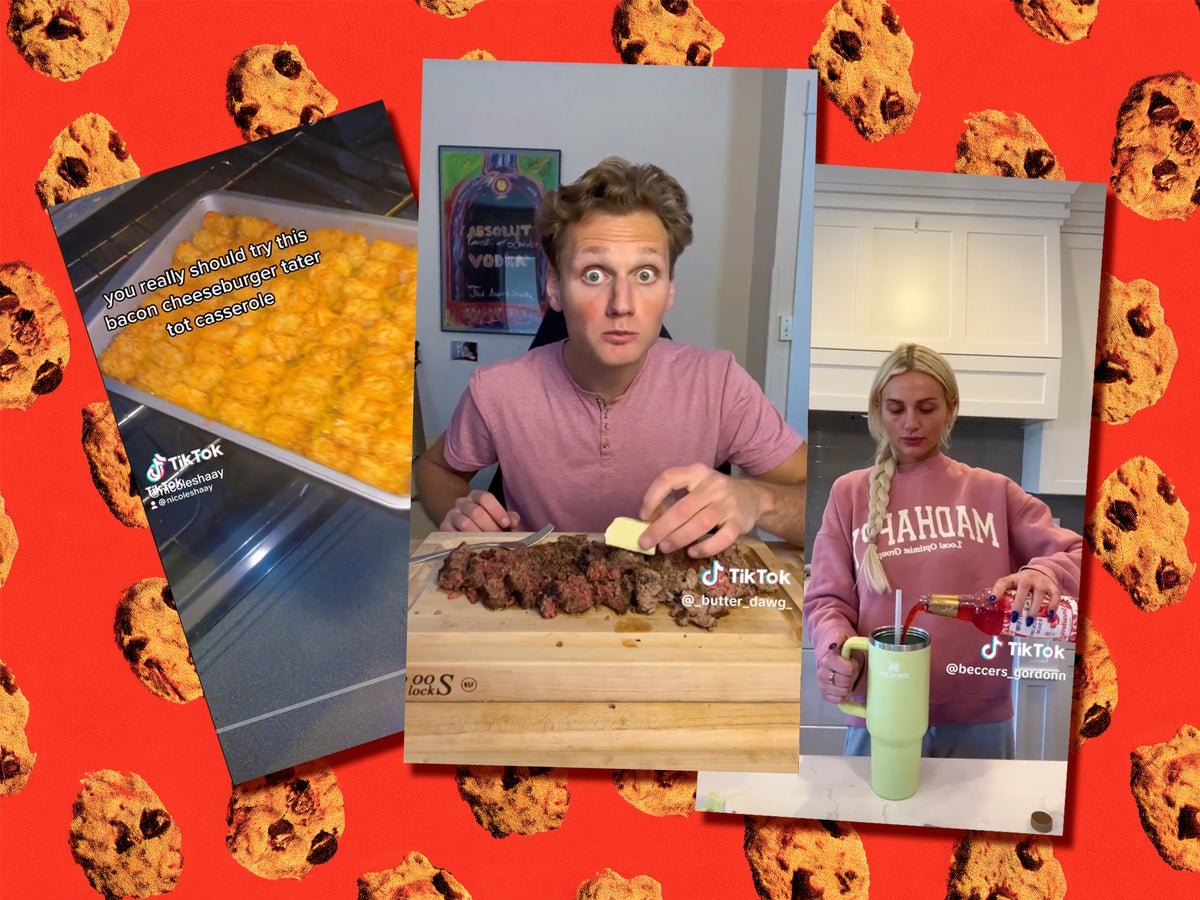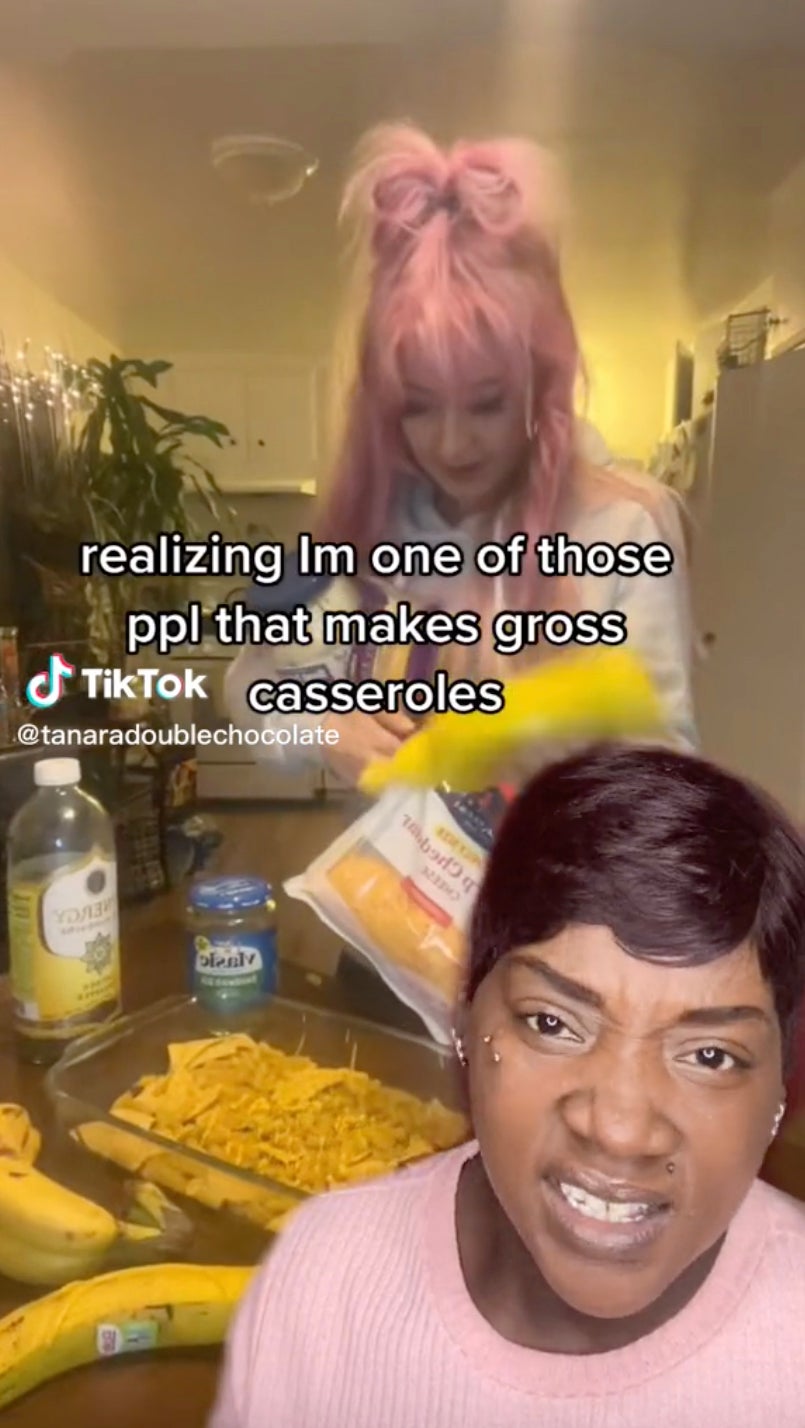
A couple of weeks ago, I became obsessed with a man known as “Butter Dawg”. He is slim, white, American and has the fluffy hair and grey hoodies of your typical frat bro. In other words, if you squint or scroll past an image of him quickly, he appears totally average. But if you linger, you notice his eyes are staring, sunken, and that he barely blinks. You’ll see that his cheeks are flushed and ruddy, like a medieval lord. Which makes sense if you watch any of Butter Dawg’s TikTok videos, because essentially his whole schtick is a fast track to debilitating gout.
Roughly six months ago, Jack Turco – Butter Dawg’s real, legal name – went viral for his unusual diet, which is made up almost entirely of animal products. In one video titled “Three tips for starting carnivore diet”, which has been viewed over three million times, Turco calmly declares that “if you go straight to a strict carnivore diet you will probably not go to the bathroom for one or two weeks at the beginning. And that’s normal.” This voiceover is layered over a sped-up video of him eating a pile of mince off a wooden chopping board, with a huge lump of butter in the middle for… seasoning, I guess, or maybe intestinal lubrication? This is a running theme in his videos, which usually involve him eating an unholy amount of calories, largely consisting of raw meat wrapped around sticks of butter. Sometimes it’s testicles, sometimes chicken boiled in bath water, and sometimes “pizzle”, aka bull’s penis.
To an outsider, the whole thing is nauseating, but also strangely fascinating – like watching a snake swallow a rodent from behind glass at a zoo. And, of course, this is exactly the point, and why I felt annoyed at myself for falling into an endless, disgusted scroll through Butter Dawg’s videos, muttering “tapeworms” under my breath. Because, while his exploits are certainly troubling from both an aesthetic and a health perspective, Butter Dawg is not unique. In this economy, he’s almost two-a-penny – just one of millions attempting to make money out of weird food content, like gross-out Rumpelstiltskins spinning foodstuffs into gold.
Pink sauce. Butter boards. Baked feta pasta. “Tacos” made by boiling beef, cheese and eggs in bags of Doritos. Since the internet pivoted to video content, food has been at its oozing centre. Wind the clock back a few years and Facebook was riddled with food-from-above videos, “how-to” hacks for meals made in mugs and extremely high-calorie feasts, mainly featuring bacon strips and Jack Daniels. Multiple content strands fed into the larger realm of food content, which could be broadly split into “recipes”, “hacks” and “gross-out.” There was also a gendered aspect to all this cooking content. Essentially, the infant algorithms of the early 2010s pushed healthy at-home “how-tos” for the girlies, and heart-stopping “don’t try this at home” videos for the guys. Often this division looked like a binge and purge cycle. Restriction was eulogised in videos dedicated to “healthy food swaps” – “avocado brownies”, “fruit pizza”, “courgetti” – which were, unsurprisingly, targeted mainly to women. Excess and overeating was touted to men as “epic” entertainment.
Today, the home of food content is TikTok. And all of these early strands – with their gendered and disordered approach to food, cooking and eating – have exploded on the platform, and, in the relentless pursuit of views and clicks, become even weirder. Butter Dawg, for example, is but one unhinged symptom of a broader online ecosystem. Simply scroll on and you’ll find people boiling crisps to make mashed potato, or shoving uncooked spaghetti into a blender to make a thicker, nastier and more time-consuming bowl of pasta. You’ll find amateur chefs turned influencers making aesthetic dishes in aesthetic kitchens. You’ll find people dumping bolognese straight onto dining tables covered in clingfilm, and women’s manicured hands rubbing aubergines and playing with warm, wet and drippy substances. From the aspirational to the revolting, everything is brought together under TikTok’s algorithm. As TikToker @Tanaradoublechocolate proclaims at the start of her videos, which dig up the most egregious and astounding examples of TikTok culinary wizardry: “Everybody’s so creative!”
FoodTok is an infinite recipe book, a source of information, comfort and entertainment, and, at the same time, a disgusting universe of ever more ungodly “hacks”, tricks and challenges. It’s both aspirational and shocking. It is also, apparently, a hub for fetish content. All those bizarre viral videos of glamorous women in booty shorts buttering up corn, or squeezing icing out of piping bags while crooning the words “ooze”, “spread” and “explode”? Welcome to sploshing, a fetish where people find sexual gratification from interacting with food, or watching others play with it. Not-so-secret sploshing content resides in the overlapping midpoint of FoodTok’s Venn diagram, with “appealing” on one side and “outrageous” on the other. In other words, it hits the two poles that make people keep scrolling.
It might all just be clickbait, but that doesn’t mean it isn’t also a dangerous expression of contemporary diet culture
Or so the theory goes. Perhaps some of these creators are blissfully unaware that the messy content they’re producing might be getting someone off somewhere? Maybe they’re just doing it for the view count? Because if there’s one thing that explains the wacky world of FoodTok more than a widespread urge to create barely-disguised fetish content, it’s the desire for success. And by success I mean monetisation. I mean the kind of social mobility that social media now offers – that of going from a nobody to a somebody, possibly with a cookbook or TV series under their belts, but definitely with hundreds of thousands of followers and bundles of cash. In this pursuit, food is simply a tool.
Some established chefs have found a solid following on TikTok. Gordon Ramsay, who has over 23 million followers, is one prime example. Yet even his popularity proves that the lifeblood of the app is non-celebrity content, as his most watched, shared and enjoyed videos are his reviews of meals prepared and uploaded by his fans. Grouped under the hashtag #ramsayreacts – which currently has more than 6 billion views – these videos essentially transform Ramsay into a living, swearing meme. But what they also show is that on TikTok, recipes made by regular folk rule. And, to really please the algorithm, the worse they are the better.
“Now anyone with a passion for food can launch their career with little more than a smartphone and a ring light,” journalist Sirin Kale wrote in a 2021 Guardian feature on TikTok’s breakout food stars. In the article, Kale spoke to Nigel Thompson of the account @teawithmrt, a 57-year-old retired Nissan supervisor from County Durham. “His videos,” Kale writes, “have the calming quality of a holiday advert – I want to pull up a chair in Thompson’s spaciously appointed kitchen, drink a glass of wine, and watch him sauté some shallots.” But, as soothing and bourgeois as this sounds, Thompson himself is less relaxed about his output. “One thing that drives me is the number of followers and likes and views,” Thompson says. “I’m always trying to beat the last number of views on my videos.”

TikTokers like Thompson have to create content that grabs attention almost immediately, as users scroll through an infinite realm of competition. Simple food or conventional recipes simply won’t cut it. Highly stylised aesthetic content can succeed, but that takes considerable time, effort and production talent. In the escalating race for views, it’s easier to just throw dry pasta and a block of cheese into a tray of milk, or eat a bull’s penis. TikTok is inherently surreal, so absurdist content flourishes. And it’s not too hard to get clicks by playing into people’s outrage or disgust, and by appealing to a culture that, let’s face it, has a pretty problematic relationship with food in general.
To me, this has been brought home most forcefully not only by Butter Dawg – who has apparently now quit college to become a full-time carnivorous content creator – but also by the recent “WaterTok” trend, in which people share ever more bizarre concoctions of ice, syrups and powders to create huge beakers of “flavoured water”. Yes, people are posting “recipes” for water now, and yes, it’s just cold, sugary juice. Yet what is interesting is the way this trend is being pushed as a fun, healthy, zero calorie trend that encourages girls – and they are all girls – to drink more water. As one prominent “water of the day” creator puts it, “we’ve got water goals to reach!”
It might all just be clickbait, and an easy way to get engagement. But that doesn’t mean it isn’t also a dangerous expression of contemporary diet culture, and of the disordered ways we’re encouraged to approach food and nutrition. I look at Butter Dawg and WaterTok and I see the same old gendered division that preaches and praises excessive consumption on one hand, and excessive control on the other. But I also see them working in tandem – excessive consumption of only animal products, and excessive consumption of only ice and sugar. To my mind, this is simply a binge and purge mindset writ large. Pleasure and punishment get muddled, in the pursuit of arbitrary “goals”, views and clicks. Then validation, success, and control.
Food is complicated, contradictory, and socially and culturally informed. It is loaded. What we eat and how we eat it can be aspirational – a signifier of class, culture and, of course, taste. It is also clearly connected to health discourses, fitness and wellness trends, able to be both a symbol of “clean”, “lean” “purity”, and of treats and “cheats”. We will probably never be able to approach it neutrally, and in the age of TikTok fame, it may always be used as a tool to achieve recognition, however wacky, warped or absurd. But, this doesn’t mean that we shouldn’t pay attention to the way FoodTok, and now WaterTok, plays into insidious cultural anxieties around consumption. Because honestly, if you look at the ever-more-extreme food and drink trends rewarded by the TikTok algorithm, sploshing seems like clean and wholesome fun.







